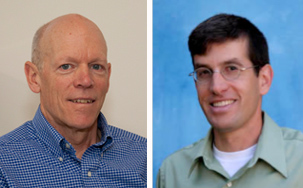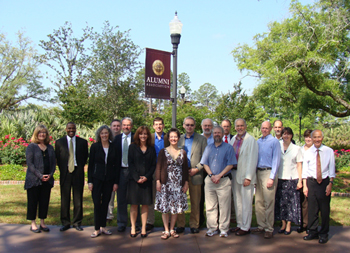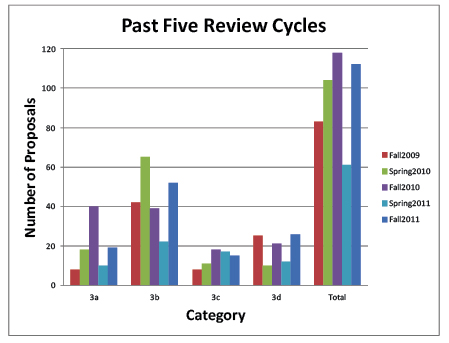PACUR: Working for UCAR members
A voice for university researchers
Feb 7, 2012 - by Staff
Feb 7, 2012 - by Staff
Greg Hakim and Jack Fellows | February 7, 2012 • The President’s Advisory Committee on University Relations (PACUR, formerly known as the University Relations Committee) was created in 1974 to help the UCAR president ensure effective communication and strengthen relations between UCAR and its member institutions. The focus of this article is to summarize PACUR’s activities and to solicit comments from members on what PACUR might do in the future on behalf of the members.

Jack Fellows (left) is the UCAR vice president for corporate affairs. Greg Hakim (right) is chair of PACUR and an associate professor in the Department of Atmospheric Sciences at the University of Washington.
The UCAR bylaws state the following about PACUR:
At each annual meeting of the Members, the Members may appoint a President’s Advisory Committee on University Relations composed of at least nine individuals, said committee to be chaired by an individual appointed by the President. The duty of said committee shall be to aid the President in improving communications between the corporation and the Members, and it shall present a report at each annual meeting of the Members.
Rick Anthes, who recently retired after more than 23 years as UCAR president (see related article), relied heavily on the PACUR for advice. New president Tom Bogdan (see related article) sees great value in PACUR and has quite a bit of history with it, as will be discussed below.
PACUR generally meets twice a year, including once on the campus of a member university (see photo below). While this committee reports to the UCAR president, it clearly is a mechanism for members to raise important community issues. PACUR (see box below) works on a broad range of activities, including planning the UCAR Annual Meeting, overseeing NCAR proposals that involve support outside the center’s core NSF funding (see box at bottom below), providing input on topics raised by the UCAR president, and supporting the selection process for several community postdoctoral and fellowship programs.

PACUR met on the campus of Florida State University in April 2011.
Since 1999, PACUR has helped plan the UCAR Annual Meeting, held each October, and worked to include forums at the meeting that address important community and national issues (see box at bottom). PACUR also typically does a post-meeting debrief to examine what parts of the Annual Meeting worked or didn’t, in an effort to continually improve this important community event.
In addition, the UCAR president periodically asks PACUR to provide advice on specific issues. One significant example in the recent past was the PACUR review and comment on the UCAR 2020 strategic plan. Many times the UCAR president will use PACUR as a sounding board prior to taking issues to the UCAR Board of Trustees.
When NCAR was created in 1960, one of the key purposes was to help the universities “mount an attack” on fundamental atmospheric science problems that were beyond the scale of an individual university department. The report issued on February 17, 1959, by the University Committee on Atmospheric Research, Preliminary Plans for a National Institute for Atmospheric Research—the “Blue Book” that established NCAR—asserted that this could be done in a way that “preserved the natural alliance of research and education without unbalancing the university programs.”
Below are members of the UCAR President’s Advisory Committee on University Relations, including each member’s institutional affiliation and the ending year of his or her current term on the committee.
Gregory Hakim (2013), chair, University of Washington
Simona Bordoni (2014) California Institute of Technology
John Braun (2014), UCAR
Eugene Cordero (2013), San Jose State University
Bob Hart (2013), Florida State University
John Martin (2012), University of Wisconsin–Madison
David Nolan (2013), University of Miami
Robert Rauber (2012), University of Illinois at Urbana–Champaign
Yvette Richardson (2013), Pennsylvania State University
Elizabeth Ritchie (2014), University of Arizona
Roger Samelson (2013), Oregon State University
Robert Street (2012), Stanford University
Jeff Trapp (2012), Purdue University
Geoffrey Vallis (2012), Princeton University
Michael Wiltberger (2014), NCAR
Sharon Zhong (2013), Michigan State University
Richard Clark, UCAR Board of Trustee Liaison (2012), Millersville University
To ensure that all UCAR programs maintain this natural alliance with the community when writing proposals for funding over and beyond core support from NSF, a process was established and administered by NSF to review how non-core proposals were handled within NCAR and UCAR Community Programs. For NCAR, “non-core” is defined as any proposals beyond its NSF base funding to run NCAR on behalf of the community. There is a somewhat different definition of non-core for UCP, since it doesn’t receive NSF base funding, but in both cases it involves proposals that are likely to go through the same review process at NSF and other agencies as would proposals from the broader community.
In l993, PACUR took on this twice-yearly oversight process at NSF’s request. The focus is not to review the details of each individual proposal, but to determine whether UCAR and NCAR senior management are ensuring that these proposals are compliant with agreed-upon criteria (see box).
The funding context in which these reviews take place has evolved over the years. NCAR’s percentage of the NSF Directorate for Geosciences (GEO) budget has been historically around 11%, and around 38% of GEO’s Division of Atmospheric and Geospace Sciences budget. In NCAR’s early years, nearly all of NCAR’s funding came from NSF. That percentage dropped to roughly 85% in the late 1970s, and it currently stands at approximately 65%.
It was always recognized by NSF that there would be some level of tension between NCAR and community proposals. In a 2010 presentation to NCAR and UCP scientists, NSF staff expressed the belief that, while this tension cannot be resolved completely, it can be constructively managed through the PACUR process. The point of these criteria and PACUR’s oversight is to make sure the process is fair and well managed.
The number of proposals reviewed by PACUR for each six-month period can vary between about 50 and 100, with an average around 75. These are proposals with individual budgets over $100,000 that have already been submitted to funding agencies. UCAR and NCAR have a 30–40% proposal success rate, so many of these proposals aren’t funded.
Given the proposal workload and the review intent (process compliance), PACUR selects a representative sample of proposals (normally a third), with a particular focus on the proposals with collaboration types 3(c) and 3(d) as shown in the box of criteria at bottom. The associated chart shows how the proposals from the past five review cycles are distributed across the PACUR criteria collaboration levels. Proposals in categories 3(a) through 3(c) all have some level of collaboration with university colleagues, and those in category 3(d) (no university collaboration) are typically focused on producing some community asset that requires a unique skill or team that exists at UCAR or NCAR (data set, tools, facilities, community models, etc). On average, 78% of the non-core proposals include university collaboration.
Since the PACUR began this review process nearly 20 years ago, the committee has examined roughly 2,000 proposals. To date, only one has been deemed by PACUR to be non-compliant with the PACUR criteria, and in that case, UCAR and PACUR agreed to disagree on the degree of collaboration. UCAR and PACUR take this review and responsibility very seriously. The process and criteria are reviewed periodically to ensure they are serving the community effectively. PACUR also periodically meets with UCAR and NCAR proposal principal investigators to ensure that all parties understand the goals and intent of the review.
PACUR has been invaluable in making sure the UCAR postdoctoral and other fellowship programs are the best that they can be. One important example is the Faculty Fellowship Program, which was proposed to PACUR in 2003 by NCAR director Tim Killeen. The FFP was intended to provide faculty an opportunity to come to NCAR for short-term visits to help them develop deeper associations and collaborations with NCAR scientists. John Merrill (University of Rhode Island), who was then the chair of PACUR, joined a couple of committee members and a couple of NCAR staff members to form a subcommittee that developed the structure of the program. This subcommittee was chaired by Tom Bogdan—at the time a NCAR senior scientist and now the incoming UCAR president. A year later Killeen announced that the FFP would be funded under NCAR’s Advanced Study Program (ASP), and he asked PACUR to play a continuing role in the program that included reviewing applications and making recommendations for appointments. The program today provides support for faculty to come to NCAR and for NCAR scientists to go to a university for 3- to 12-month visits. In the past couple of years, NCAR has been able to fund all of the FFP applications, so PACUR has not needed to review applications or make recommendations. However, the committee did review the applications for 2012 and will continue to do so in the coming years.
The NCAR Graduate Visitor Program is also administered in ASP. The program began in 2006 with strong guidance and support from PACUR. It provides travel and per diem support for graduate students and advisor visits while they are at NCAR for 3- to 12-month visits to pursue their research. The program remains a high priority for ASP and will support approximately 30 students in 2012.
The ASP Postdoctoral Fellowship Program is one of NCAR’s flagship programs. Although PACUR is not directly involved with the application or selection process of this program, it was brought to PACUR’s attention a few years ago that there may be bias toward Colorado applicants. PACUR took this issue on and examined whether there was in fact a geographical bias in the selection process. Through discussions with Maura Hagan, past ASP director and current NCAR deputy director, and Chris Davis, the current ASP director, PACUR gained a better understanding of the entire review and selection process. It was determined that in some years there had been a disproportionate number of awardees from Colorado, but that this did not emerge from an intentional geographic bias and had more to do with the fact that fewer Colorado applicants turn down these appointments. Nonetheless, ASP is aware of the potential for geographical bias and will continue to monitor the issue in the selection process.
We believe PACUR plays an important role in providing advice to the UCAR President on a broad range of topics and provides community oversight on issues like non-core proposals and other important community programs, such as the fellowship and postdoctoral programs mentioned above. We also believe that PACUR is an important mechanism for UCAR members to raise issues and express opinions. We’d be particularly interested in knowing what issues are important to you so we can examine whether UCAR can help address them, as well as ideas you might have for future UCAR Annual Meetings. You can raise an issue by simply sending an email to pacurchair@ucar.edu. We hope to hear from you soon.
a. High-Performance Computing
b. Observational
c. Research Data
d. Community Models
e. None
f. Explain how the proposed activity does not utilize these facilities in a way that is not available to the typical university investigator.
a. Joint (e.g., separate proposal from UCAR and each university institution). No further explanation needed provided the proposal is clear as to how it supports and complements the community.
b. Collaborative with funding to or from university partner. No further explanation needed provided the proposal is clear as to how it supports and complements the community.
c. Collaborative with no funding to or from university partner. Describe in detail the nature of the collaboration including letters of collaboration. The collaboration should be significant and meaningful. The level and scope of the collaboration must be clearly stated (including graduate student participation if applicable) in both the Advance Notice Forms and in the letters of collaboration. In addition, it must be clearly stated how this collaboration is supportive of and complementary to the university PI.
d. No university collaboration. Explain how the proposed activity supports and complements the university community through: 1) contribution to the development or support of community facilities, community models, community data sets, or other community projects such as field programs, workshops, visitor programs, or community meetings, or 2) development or transfer of UCAR-developed technology or expertise to the scientific community or to society at large with demonstrable benefit to the community and to society.

Comparison of the proposal distribution in the past five review cycles, based on the numerical/alphabetic categories shown above.